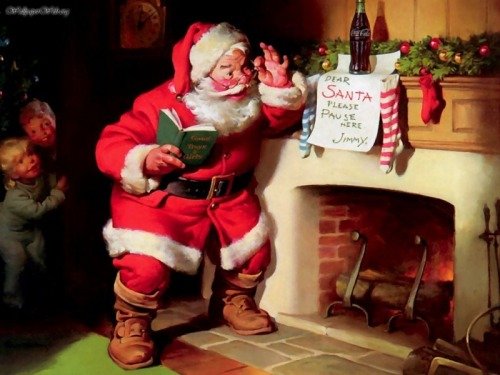historysquee:A Brief History of Santa Santa Claus, also known as Father Christmas or more traditio
historysquee: A Brief History of Santa Santa Claus, also known as Father Christmas or more traditionally Saint Nicholas, is a character with many different origins, stories and traditions around the world. There are many historical and legendary figures that the modern day Santa is based on. He can be seen as largely a mix of Saint Nicholas, Sinterklaas and Father Christmas. The name Santa Claus for example, is an Americanised version of the Dutch Sinterklaas. Possibly the earliest of these figures is Saint Nicholas of Myra, who was a 4th Century bishop who was generous with gifts and money, including giving dowries to three woman who otherwise would have had to become prostitutes. Another possible influence on the idea of Santa is the Norse God, Odin. Odin apparently rode through the sky on an eight legged horse and some children left food for the horse out near their chimneys, which Odin would apparently take and replace with sweets for their kindness. The Dutch Sinterklaas is another popular figure, who has a list of good and naughty children and rewards the good children with presents, with his helpers, the Black Peter. Sinterklass is described as riding a horse over rooftops, dropping presents into the chimneys of the well behaved, while the helpers carry sticks and sacks, to catch the naughty children with. The British tradition of Father Christmas dates back to the 15th Century but became popular only in the 17th Century. Father Christmas is shown as a bearded man who wore a green, fur lined robe. He was associated with drinking and adult feasts initially, until the various Santa’s merged, and Santa Claus and Father Christmas became synonyms in Britain. In the 1800’s, the Santa figure began to evolve into the figure we are familiar with today. He became drawn as a chubbier man who lived at the North Pole, an idea which was popularised by the famous cartoonist Thomas Nast. It is suggested that Nast began to make the idea of a red suited Santa popular in the late 1800’s, although he had appeared in red before this in many depictions. It was the Coca-Cola advertising campaigns in the 1930’s and on that made the image the commercialised success that it is today. Children today can write letters to Santa that are replied to by volunteers working for the postal services of many countries. Santa can also be ‘tracked’ online, through various websites that show Santa’s progress around the world on Christmas Eve. Other than these technical advances, over the last 200 years, Santa has gained a wife, reindeer and a team of elves who help in his job of delivering presents. -- source link
Tumblr Blog : historysquee.tumblr.com





